Healing - Experience - Kumano Kaido Old road (No.4)
Healing - Experience -
Nakaheji
Old road (No.1)
Healing -
Experience - Okumotori,
Kogumotori Old road (No.2)
Healing -
Experience - From Hongu to
Shingu (No.3)
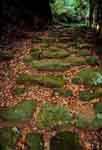 Near Kumano City, in the town of Hatasu, the
remains of the 'Kumano Iseji Road' can be found. 'Hatasu'
is a name which signifies an important relation to the
coming of Jofuku to this area more than two thousand
years ago. This road may have been one of the main roads
by which culture and technology from the outside world
reached inland Japan as well as being the route which
brought pilgrims back to Kumano, the source of this
cultural influence at that time. References to the
'Kumano Old Road-Iseji Road', in connection with Japan's
most holy shrine Ise Jingu, can be found in some texts in
Noh plays. The road at that time was steep and dangerous
and people took on a good deal of hardship to traverse
it. Still, thousands of pilgrims walked the road since
ancient times believing that they were on the road of
'vast benevolence' and treading the path leading to
'rebirth'.
Near Kumano City, in the town of Hatasu, the
remains of the 'Kumano Iseji Road' can be found. 'Hatasu'
is a name which signifies an important relation to the
coming of Jofuku to this area more than two thousand
years ago. This road may have been one of the main roads
by which culture and technology from the outside world
reached inland Japan as well as being the route which
brought pilgrims back to Kumano, the source of this
cultural influence at that time. References to the
'Kumano Old Road-Iseji Road', in connection with Japan's
most holy shrine Ise Jingu, can be found in some texts in
Noh plays. The road at that time was steep and dangerous
and people took on a good deal of hardship to traverse
it. Still, thousands of pilgrims walked the road since
ancient times believing that they were on the road of
'vast benevolence' and treading the path leading to
'rebirth'.  Although pilgrims on the 'Kumano Old Road'
suffered some hardship it was not entirely without its
pleasures too. The magnificent scenery, the hotsprings,
the lush forests, and the splendid beaches along the
Pacific coast allowed some respite for the pilgrims on
their way to the Grand Shrines of Kumano. In the hustle
and bustle of our highly technological,
commodity-abundant, and fast-paced lives Kumano still
offers the modern pilgrim some respite from the pressures
of modernity and offers some glimpse into the past and
into the future and begs us to consider the possibility
of a life in coexistence with nature. The Kumano Old Road
perhaps can allow us to discover here in Kumano some of
the richness lost in the rush of urban living.
Although pilgrims on the 'Kumano Old Road'
suffered some hardship it was not entirely without its
pleasures too. The magnificent scenery, the hotsprings,
the lush forests, and the splendid beaches along the
Pacific coast allowed some respite for the pilgrims on
their way to the Grand Shrines of Kumano. In the hustle
and bustle of our highly technological,
commodity-abundant, and fast-paced lives Kumano still
offers the modern pilgrim some respite from the pressures
of modernity and offers some glimpse into the past and
into the future and begs us to consider the possibility
of a life in coexistence with nature. The Kumano Old Road
perhaps can allow us to discover here in Kumano some of
the richness lost in the rush of urban living.  Kumano Kaido High Road', another name for the
Iseji road, is the road of pilgrimage from Ise to Kumano.
This road passes over Mt. Yagi which is on the west side
of Owase City. This part of the road is the hardest part
of the Kumano Kaido.
Kumano Kaido High Road', another name for the
Iseji road, is the road of pilgrimage from Ise to Kumano.
This road passes over Mt. Yagi which is on the west side
of Owase City. This part of the road is the hardest part
of the Kumano Kaido.  The photo here shows members of the Kumano
Field Museum Tour (1994) being guided over Mt Yagi. The
road over Yagiyama Pass in Owase City is reminiscent of
the original 'Kumano Kaido High Road'. It is said to have
been one of the most difficult parts of the Kumano Kaido.
This road passes through Japanese Cypress forests unlike
the Kumano Old Road which is famous for its cedar
forests.
The photo here shows members of the Kumano
Field Museum Tour (1994) being guided over Mt Yagi. The
road over Yagiyama Pass in Owase City is reminiscent of
the original 'Kumano Kaido High Road'. It is said to have
been one of the most difficult parts of the Kumano Kaido.
This road passes through Japanese Cypress forests unlike
the Kumano Old Road which is famous for its cedar
forests.
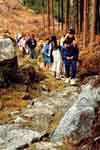 The part of the
road from Owase City to the pass remains the same as in
ancient times, featuring many old stone walls and
milestones all along the way.
The part of the
road from Owase City to the pass remains the same as in
ancient times, featuring many old stone walls and
milestones all along the way.
to the top
 Several milestones or 'chouseki' can be found
along the Kumano Kodo Old Road on Yagi Mountain. They
were all made in the shape of Jizobosatsu (Boddhisatva)
by promoters and guides of the Kumano pilgrimages to the
Ise Shrine.
Several milestones or 'chouseki' can be found
along the Kumano Kodo Old Road on Yagi Mountain. They
were all made in the shape of Jizobosatsu (Boddhisatva)
by promoters and guides of the Kumano pilgrimages to the
Ise Shrine. 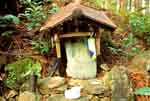 There also remain tombstones of the pilgrims
who died during their pilgrimages along this road. The
oldest Buddhist statue on this road was made in 1569.
There also remain tombstones of the pilgrims
who died during their pilgrimages along this road. The
oldest Buddhist statue on this road was made in 1569.
tp the top
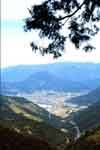 From Mt. Yagi one can enjoy this view of Owase
City and Magose Toge Pass. Travelling the Kumano Kodo
Iseji Road, you can see the hamlet of Kuki quietly
nestled into a bay on the Pacific Ocean. You can also
take in the view of Hidegatake, the highest peak of
Odaigahara.
From Mt. Yagi one can enjoy this view of Owase
City and Magose Toge Pass. Travelling the Kumano Kodo
Iseji Road, you can see the hamlet of Kuki quietly
nestled into a bay on the Pacific Ocean. You can also
take in the view of Hidegatake, the highest peak of
Odaigahara. 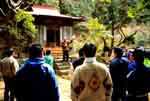 Also called 'Nichirinji Temple', Koujin Do is
located near the summit of Mt. Yagi. It is said to have
been built in 702. In the past there used to be teahouses
and other facilities nearby at the height of the Kumano
Mode Pilgrimage era. Traditionally this was also the
place for preparing for the '33 Kannon Temple Pilgrimage
in the Kansai region of western Japan. Even now Shugendo
(Mountain Buddhism) devotees perform regular rituals at
Koujin Do although they do not reside there on a
permanent basis.
Also called 'Nichirinji Temple', Koujin Do is
located near the summit of Mt. Yagi. It is said to have
been built in 702. In the past there used to be teahouses
and other facilities nearby at the height of the Kumano
Mode Pilgrimage era. Traditionally this was also the
place for preparing for the '33 Kannon Temple Pilgrimage
in the Kansai region of western Japan. Even now Shugendo
(Mountain Buddhism) devotees perform regular rituals at
Koujin Do although they do not reside there on a
permanent basis. 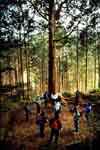 In modern times the distances between milestones
and how they are placed have been altered over time.
In modern times the distances between milestones
and how they are placed have been altered over time.  The reason for this is that local historians
have gathered those milestones which were dislocated
through natural disasters and relocated them in different
places.
The reason for this is that local historians
have gathered those milestones which were dislocated
through natural disasters and relocated them in different
places. 
 Magose Toge Pass, between Miyama Town and Owase,
still features an old stone paved road, made in the Edo
Era, which is kept just as it was in the days of the
Kumano Pilgrimage. After passing over this summit
pilgrims would enter into Owase city on their way to
Kumano from Ise.
Magose Toge Pass, between Miyama Town and Owase,
still features an old stone paved road, made in the Edo
Era, which is kept just as it was in the days of the
Kumano Pilgrimage. After passing over this summit
pilgrims would enter into Owase city on their way to
Kumano from Ise. | Back to Previous Page | Back to Experience-Healing Home | Go to Main Menu |